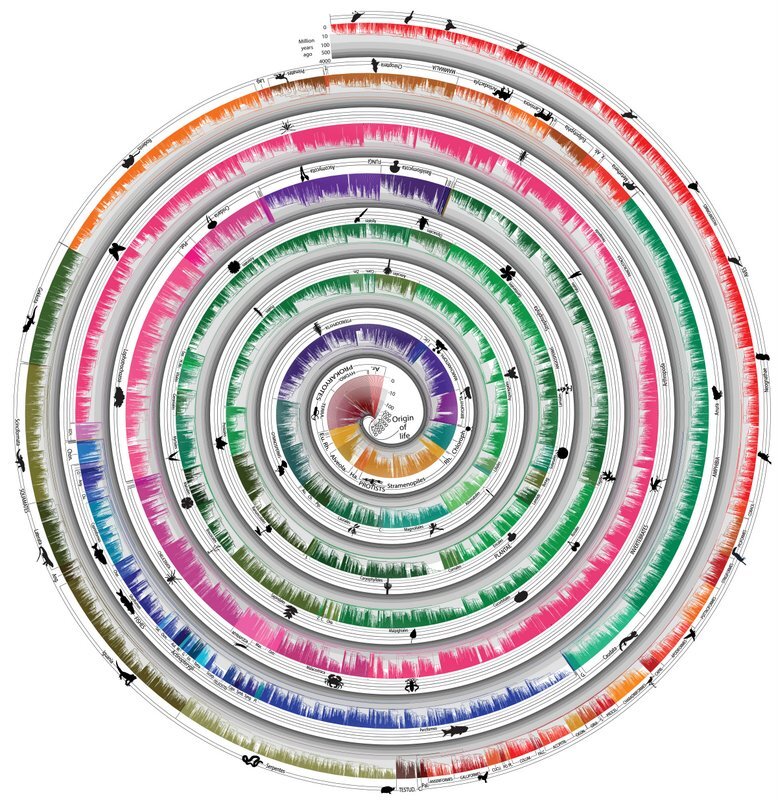
Temple University researchers have assembled the largest and most accurate tree of life calibrated to time, and surprisingly, it reveals that life has been expanding at a constant rate. The model also has implications for human evolution.
“The constant rate of diversification that we have found indicates that the ecological niches of life are not being filled up and saturated,” said Temple professor S. Blair Hedges, a member of the research team’s study, published in the early online edition of the journal Molecular Biology and Evolution. “This is contrary to the popular alternative model which predicts a slowing down of diversification as niches fill up with species.”
The tree of life compiled by the Temple team is depicted in a new way—a cosmologically-inspired galaxy of life view—and contains more than 50,000 species in a tapestry spiraling out from the origin of life.
For the massive meta-study effort, researchers painstakingly assembled data from 2,274 molecular studies, with 96 percent published in the last decade. They built new computer algorithms and tools to synthesize this largest collection of evolutionary peer-reviewed species diversity timelines published to date to produce this Time Tree of Life.
___________________________________
The tree of life compiled by Temple University researchers is depicted in a new way—a cosmologically inspired galaxy of life view—and contains more than 50,000 species in a tapestry spiraling out from the origin of life. Credit: Temple University
________________________________________
The study also challenges the conventional view of adaptation being the principal force driving species diversification, but rather, underscores the importance of random genetic events and geographic isolation in speciation, taking about 2 million years on average for a new species to emerge onto the scene.
“This finding shows that speciation is more clock-like than people have thought,” said Hedges. “Taken together, this indicates that speciation and diversification are separate processes from adaptation, responding more to isolation and time. Adaptation is definitely occurring, so this does not disagree with Darwinism. But it goes against the popular idea that adaptation drives speciation, and against the related concept of punctuated equilibrium which associates adaptive change with speciation.”
“In terms of how humans relate to our finding, it follows that, as we are just another species, the origin of our lineage has more to do with geographic isolation than with adaptation,” Hedges told Popular Archaeology.
Besides the new evolutionary insights gained in this study, their Timetree of Life will provide opportunities for researchers to make other discoveries across disciplines, wherever an evolutionary perspective is needed, including, for example, studies of disease and medicine, and the effect of climate change on future species diversity.
Researchers around the world utilize molecular clocks to estimate species divergence times, calculating DNA mutational rates with species divergence times from gene and genomic sequences, that together with the fossil record and geological history, provide a constantly improving view of Darwin’s “grandeur of life.”
These new results add to the decade-long efforts of the Timetree of Life initiative (TTOL), which includes internet tools and a book, led by team members Hedges and Sudhir Kumar. “The ultimate goal of the TTOL is to chart the timescale of life — to discover when each species and all their ancestors originated, all the way back to the origin of life some four billion years ago,” said Hedges.
As an ongoing service to the scientific community, Hedges and Kumar plan to continue adding new data to TTOL from future peer-reviewed studies. They also will improve their current tools, such as web and smartphone apps, and develop new tools, that will make it easier to access the information and to explore the TTOL, and for scientists to update the growing tree with their new data.
____________________________________________
Besides Hedges and Kumar, other members of the research team that published this new article included Julie Marin, Michael Suleski, and Madeline Paymer.
____________________________________________
Source: Temple University press release.
____________________________________________
Read about the most fascinating discoveries with a premium subscription to Popular Archaeology Magazine. Find out what Popular Archaeology Magazine is all about. AND MORE:
On the go? Get the smartphone version of Popular Archaeology as an app or as an ebook.
Just released!
The special new premium quality print edition of Popular Archaeology Magazine. A beautiful volume for the coffee table.
Travel and learn with Far Horizons.
____________________________________________
Popular Archaeology’s annual Discovery Edition eBook is a selection of the best stories published in Popular Archaeology Magazine in past issues, with an emphasis on some of the most significant, groundbreaking, or fascinating discoveries in the fields of archaeology and paleoanthropology and related fields. At least some of the articles have been updated or revised specifically for the Discovery edition. We can confidently say that there is no other single issue of an archaeology-related magazine, paper print or online, that contains as much major feature article content as this one. The latest issue, volume 2, has just been released. Go to the Discovery edition page for more information.







